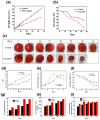Recycled Sericin Biopolymer in Biotechnology and Bioelectronics
- PMID: 40428166
- PMCID: PMC12108825
- DOI: 10.3390/bioengineering12050547
Recycled Sericin Biopolymer in Biotechnology and Bioelectronics
Abstract
In a world characterized by rapid industrialization and a growing population, plastic or polymeric waste handling has undergone significant transformations. Recycling has become a major strategy where silk sericin has great potential among recyclable polymers. This naturally occurring biopolymer is a sustainable and versatile material with a wide range of potential uses in biotechnology and sensing. Furthermore, preparing and studying new environmentally friendly functional polymers with attractive physicochemical properties can open new opportunities for developing next-generation materials and composites. Herein, we provide an overview of the advances in the research studies of silk sericin as a functional and eco-friendly material, considering its biocompatibility and unique physicochemical properties. The structure of silk sericin and the extraction procedures, considering the influence of preparation methods on its properties, are described. Sericin's intrinsic properties, including its ability to crosslink with other polymers, its antioxidative capacity, and its biocompatibility, render it a versatile material for multifunctional applications across diverse fields. In biotechnology, the ability to blend sericin with other polymers enables the preparation of materials with varied morphologies, such as films and scaffolds, exhibiting enhanced mechanical strength and anti-inflammatory effects. This combination proves particularly advantageous in tissue engineering and wound healing. Furthermore, the augmentation of mechanical strength, coupled with the incorporation of plasticizers, makes sericin films suitable for the development of epidermal electrodes. Simultaneously, by precisely controlling hydration and permeability, the same material can be tailored for applications in packaging and the food industry. This work highlights the multidisciplinary and multifunctional nature of sericin, emphasizing its broad applicability.
Keywords: bioelectronics; biopolymers; biosensors; biotechnology; green chemistry; silk sericin; sustainability; tissue engineering.
Conflict of interest statement
The authors declare no conflicts of interest.
Figures










Similar articles
-
Silk Sericin and Its Effect on Skin Wound Healing: A State of the Art.Macromol Biosci. 2024 Oct;24(10):e2400145. doi: 10.1002/mabi.202400145. Epub 2024 Jul 29. Macromol Biosci. 2024. PMID: 39073276 Review.
-
Silk Sericin Protein Materials: Characteristics and Applications in Food-Sector Industries.Int J Mol Sci. 2023 Mar 3;24(5):4951. doi: 10.3390/ijms24054951. Int J Mol Sci. 2023. PMID: 36902381 Free PMC article. Review.
-
Silk sericin: A versatile material for tissue engineering and drug delivery.Biotechnol Adv. 2015 Dec;33(8):1855-67. doi: 10.1016/j.biotechadv.2015.10.014. Epub 2015 Oct 31. Biotechnol Adv. 2015. PMID: 26523781 Review.
-
Advancements in silk fibroin and silk sericin-based biomaterial applications for cancer therapy and wound dressing formulation: A comprehensive review.Int J Pharm. 2024 Sep 5;662:124494. doi: 10.1016/j.ijpharm.2024.124494. Epub 2024 Jul 20. Int J Pharm. 2024. PMID: 39038721 Review.
-
Protein composites from silkworm cocoons as versatile biomaterials.Acta Biomater. 2021 Feb;121:180-192. doi: 10.1016/j.actbio.2020.11.037. Epub 2020 Nov 26. Acta Biomater. 2021. PMID: 33249226 Free PMC article.
References
-
- Bandh S.A., Malla F.A., Wani S.A., Hoang A.T. Waste Management in the Circular Economy. Springer; Cham, Switzerland: 2024. Waste Management and Circular Economy; pp. 1–17.
-
- Marques G.G., Couffin A., Hajji P., Inoubli R., Bounor-Legaré V., Fulchiron R. A Review on the Formulation and Rupture Properties of Polyethylene Terephthalate in a Mechanical Recycling Context. Ind. Eng. Chem. Res. 2023;63:887–920. doi: 10.1021/acs.iecr.3c02376. - DOI
Publication types
Grants and funding
LinkOut - more resources
Full Text Sources

